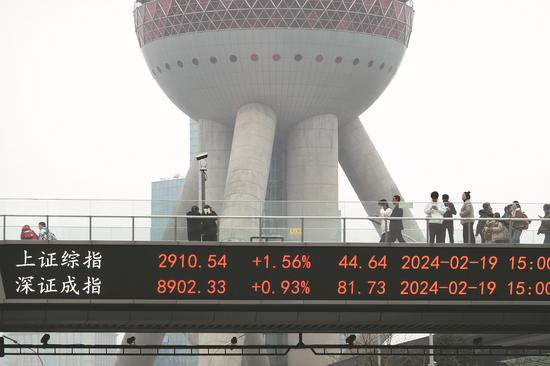Capital market set for sound development
[ad_1]

Stock index levels are seen on an overpass in Shanghai. (WANG GANG/FOR CHINA DAILY)
With 600m investors buying fund products, sustainability, society enter bourses’ lexicon
Now that the first quarter of this year is history, insiders of China’s A-share market are convinced the challenges and chaos that seemed daunting at the beginning of the new year remain stiff, with quick solutions appearing unlikely.
Investors’ nerve was initially shaken by the benchmark Shanghai Composite Index sinking to below 2,700 points. The bumpy trading eventually ended in early February with the “national team” — mainly the sovereign wealth fund’s investment arm Central Huijin — injecting more liquidity and regulators straightening up trading rules. This helped the SCI regain the psychological fulcrum of 3,000 points shortly after Spring Festival in early February.
While trading becomes active again as indexes rise, talk on the high-quality development of the A shares, on which will depend a sustained long-term bull market, has picked up heat again.
Looking back at the chaos at the beginning of the year, market mavens blamed it all on inadequate market liquidity. The collective redemption of mutual fund products due to their declining net asset value, the collective knock-in of auto-callable notes (meaning investors needed to increase investment or confront forced closing of positions for this structured product) and the closing positions for many margin trading-based products, had dragged down the SCI and seriously impaired market sentiment, resulting in panic and a sell-off.
Now, the focus has shifted to the anticipated introduction of a stock market stabilization fund.
Liu Yuhui, a council member of the China Chief Economist Forum, compared today’s Chinese stock market to a “voting machine” that reflects investor confidence. The anticipated market stabilization fund, or even a simple announcement about its introduction, will likely profoundly improve investor sentiment, he said.
“When the market is jittery, the stabilization fund may not make any move at all. The fund itself serves as a symbol of bolstered confidence. People do not really care about how much money is poured into the stabilization fund. The felt solid government presence behind the fund is what investors truly value,” he said.
Market entities, nevertheless, have their own expectations of the fund’s corpus. CITIC Securities estimates that a stabilization fund valued between 2 trillion yuan ($277 billion) and 5 trillion yuan will be enough as such a fund usually takes up 3 percent to 6 percent of the stock market value in other mature markets.
“The introduction of a stabilization fund is quite necessary and China is ready for that,” said Li Xunlei, chief economist of Zhongtai Securities.
Another hot topic to figure in market buzz is the possible replacement of the current T+1 trading mechanism with a T+0 mechanism after the A-share market stabilizes. The T+0 system will allow purchase and sale of the same shares within the day.
Independent stock market analyst Pi Haizhou said one major merit of the T+0 mechanism is that it can largely increase investors’ capital efficiency and boost trading activity.
He Qiang, a professor of the School of Finance at the Central University of Finance and Economics, said the T+0 mechanism can help retail investors to reduce losses by taking prompt corrective action upon wrong moves. Trials can be first undertaken for trading blue-chip large-caps or at the Beijing Stock Exchange, the youngest of the bourses on the Chinese mainland, he said.
“Futures trading, which entails higher risks, is conducted under the T+0 mechanism all over the world, only to avoid risks by reducing losses on a daily basis,” he said.
Tian Xuan, associate dean of Tsinghua University’s PBC School of Finance. said that the Shanghai and Shenzhen bourses are the only two exchanges using the T+1 trading mechanism. The T+0 mechanism is adopted at 42 stock exchanges across the world.
“Under the T+1 mechanism, institutional investors can use stock index futures, exchange-traded fund arbitrage and reverse margin trading to cover losses or even seek gains on days of higher market fluctuations. But retail investors are deprived of such choices. They are not able to make up for or reduce their losses under the current T+1 mechanism within the day once they make mistakes,” said Tian.
“This is contrary to the principle of market fairness, and is not conducive to the financial market’s stability.”
Tian further said China briefly used the T+0 mechanism at the beginning of its modern-era stock market. But it shifted to T+1 in 1995 due to the then inadequate supervision and legal system and the limited choices in the stock market.
“But the Chinese capital market has made substantial progress over the past decade. The supervision, legal system, investable target and financial tools have all been completed. I think it is time to talk about restoring the T+0 mechanism,” he said.
[ad_2]
Read More:Capital market set for sound development



 Canada
Canada Japan
Japan Germany
Germany Australia
Australia United States
United States United Kingdom
United Kingdom China
China France
France Ukraine
Ukraine Russia
Russia Turkey
Turkey
Comments are closed.